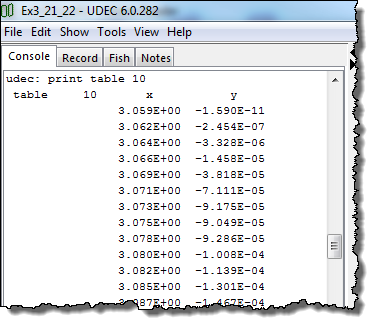Tables
Tables are convenient data structures consisting of a number of x,y pairs.

They are used in UDEC:
- In model construction to build blocks, define joints and create excavations;
- To load and velocity histories (paths) for model boundaries;
- To vary friction, cohesion, dilation, tensile strength and cap pressure with accumulated plastic strain for the strain-softening and double-yield models;
- To vary normal stress versus normal displacement for joint-area contact Coulomb slip (with and without residual strength);
- To vary fluid density or joint permeability with temperature;
- To initialize temperatures in the model;
- Store history data; and
- To define colors for filled plots.
Tables may be printed, plotted and imported or exported as ASCII data files.
Histories
Histories are recordings of any one of 55 pre-selected variables (e.g., pore pressure, centroid, stresses, temperature, displacements, etc.) at a user-defined location (some block, contact, zone or gridpoint). By default histories are recorded every 10 calculation cycles, but this can be selected by the user. A time history of as many as 500 variables can be made in one run. Histories may be printed, plotted (versus time, steps or another history), converted to Tables and exported as an ASCII data file.
